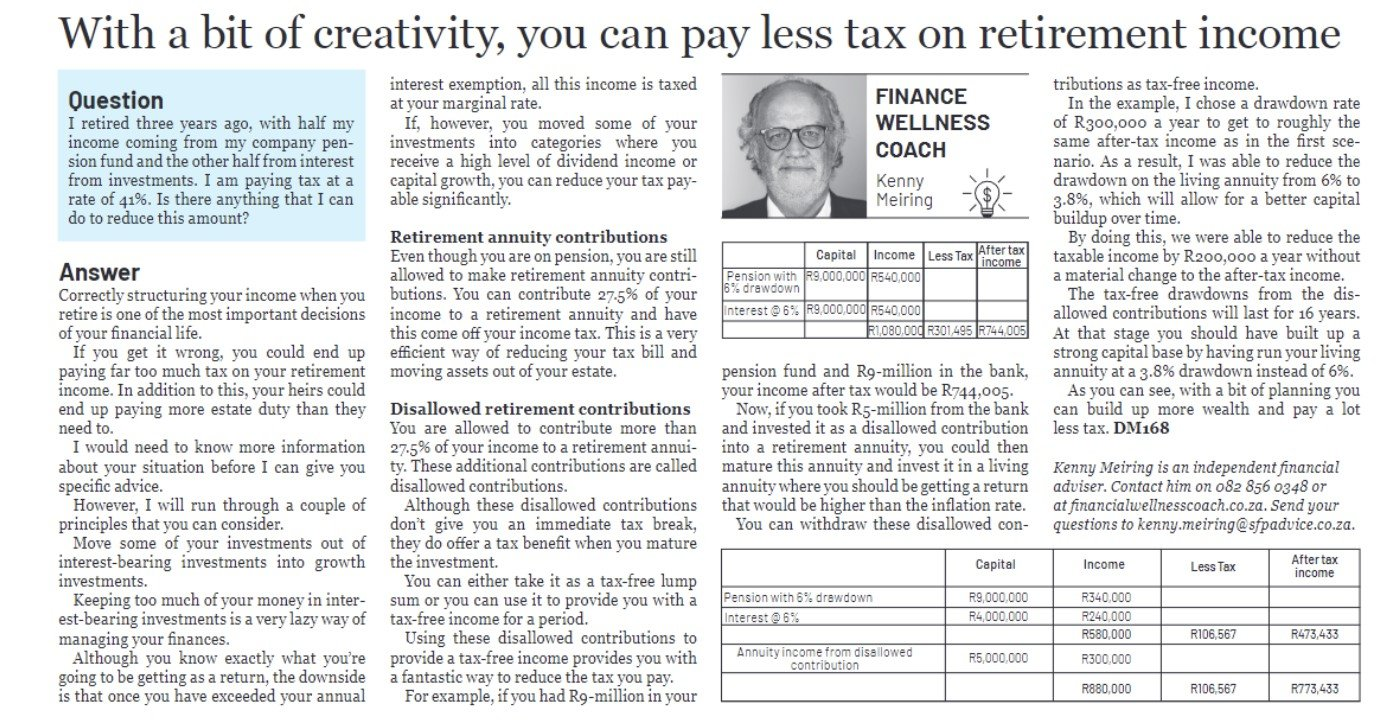114 – How to structure your retirement income to pay the least amount of tax
Question
I retired three years ago, with half my income coming from my company pension fund and the other half from interest from investments. I am paying tax at a rate of 41%. Is there anything that I can do to reduce this amount?
Answer
Correctly structuring your income when you retire is one of the most important decisions of your financial life. If you get it wrong, you could end up paying far too much tax on your retirement income. In addition to this, your heirs could end up paying more estate duty than they need to.
I would need to know more information about your situation before I can give you specific advice, however, I will run through a couple of principles that you can consider.
Move some of your investments out of interest-bearing investments into growth investments
Keeping too much of your money in interest bearing investments is a very lazy way of going about managing your finances. While you know exactly what you’re going to be getting as a return, the downside is that once you have exceeded your annual interest exemption, all this income is taxed at your marginal rate.
If, however, you moved some of your investments into categories where you receive a high level of dividend income or capital growth, you can reduce your tax payable significantly.
Retirement annuity contributions
Even though you are on pension, you are still allowed to make retirement annuity contributions. You can contribute 27.5% of your income to a retirement annuity and have this come off your income tax. This is a very efficient way of reducing your tax bill and moving assets out of your estate.
Disallowed retirement contributions
You are allowed to contribute more than 27.5% of your income to a retirement annuity. These additional contributions are called disallowed contributions. While these disallowed contributions don’t give you an immediate tax break, they do offer a tax benefit when you mature the investment. You can either take it as a tax-free lump sum or you can use it to provide you with a tax-free income for a period.
Using these disallowed contributions to provide a tax free income provides you with a fantastic way to reduce the tax that you pay.
For example,
If you had R9m in your pension fund and R9m in the bank, your income after tax would be R744 005
|
|
Capital |
Income |
Less Tax |
After tax income |
|
Pension with 6% drawdown |
R9,000,000 |
R540,000 |
|
|
|
Interest @ 6% |
R9,000,000 |
R540,000 |
|
|
|
|
|
R1,080,000 |
R301,495 |
R744,005 |
Now, if you took R5m from the bank and invested it as a disallowed contribution to an RA. You could then mature this RA and invest it in a living annuity where you should be getting a return that would be higher than the inflation rate.
You can withdraw these disallowed contributions as a tax-free income.
I chose a drawdown rate of R300 000 a year to get to roughly the same after-tax income as the first scenario. As a result, I was able to reduce the drawdown on the living annuity from 6% to 3.8% which will allow for a better capital build up over time.
We now have:
|
|
Capital |
Income |
less Tax |
After tax income |
|
Pension with 3.8% drawdown |
R9,000,000 |
R340,000 |
|
|
|
Interest @ 6% |
R4,000,000 |
R240,000 |
|
|
|
|
|
R580,000 |
R106,567 |
R473,433 |
|
Annuity income from Disallowed Contribution |
R5,000,000 |
R300,000 |
|
|
|
|
|
R880,000 |
R106,567 |
R773,433 |
Through this, we were able to reduce the taxable income by R200 000 a year without a material change to the after-tax income.
The tax-free drawdowns from the disallowed contributions will last for 16 years. At that stage you should have built up a strong capital base by having run your living annuity at a 3.8% drawdown instead of 6%.
As you can see, with a bit of planning you can build up more wealth and pay a lot less tax.
KENNY MEIRING IS AN INDEPENDENT FINANCIAL ADVISER
Contact him via phone, email or via contact phone on the financialwellnesscoach.co.za website

Read more of our articles on the Daily Maverick website or newspaper weekly!










